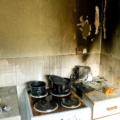
Facing the aftermath of a fire in a commercial property can be overwhelming, with potential disruptions to business operations and financial strain looming. The real challenge lies in repairing physical damage and navigating the complex process of restoring normalcy while keeping business interruption to a minimum. For commercial property owners and business operators, strategic planning and swift action are essential to minimizing downtime and safeguarding business continuity. The challenge for Singapore’s commercial property owners and business operators extends beyond physical restoration. It encompasses the intricate dance of reviving operations while navigating the complex fire damage remediation process. In this high-stakes scenario, minimizing downtime becomes not just a goal but an imperative—a race against time where every decision can impact the bottom line and the very survival of the enterprise.
This blog delves into the critical strategies that can ensure efficient fire damage restoration while minimizing disruption to business operations in Singapore’s commercial properties. It will explore a suite of approaches designed to expedite recovery, maintain business continuity, and emerge more robust and resilient. From immediate response protocols to innovative restoration techniques, these strategies offer a roadmap for businesses to navigate the challenging terrain of post-fire recovery with minimal interruption and maximal efficiency.
The Impact of Fire Damage on Business Operations
Fire incidents can have severe and far-reaching consequences for business operations, often resulting in substantial financial losses and operational challenges. A comprehensive understanding of these impacts is crucial for organizations to implement effective preparedness measures and respond efficiently in the aftermath of such events.
Short-term Ramifications of Fire Damage
The primary and most visible consequence of a fire in a commercial setting is the destruction of physical assets. This includes damage to the building’s structure, office equipment, technological infrastructure, machinery, etc. The severity of damage may vary, but even a relatively minor fire can render portions of a facility inoperable, leading to immediate disruptions in business continuity.
In addition to the loss of physical assets, fire damage often results in the need to shut down operations temporarily. This downtime can be particularly detrimental to businesses that rely on continuous operations, such as retail establishments, food service providers, and offices offering essential services. The inability to function halts revenue generation and may result in missed deadlines, unfulfilled orders, and lost business opportunities.
Moreover, fire damage can create hazardous conditions within the building, such as compromised structural integrity, water damage from firefighting efforts, and soot, smoke, and hazardous chemicals. These hazards must be addressed before restoration work begins, further delaying the return to normal operations.
Long-Term Implications of Prolonged Business Interruption
While the immediate effects of fire damage are often the most apparent, the long-term consequences of extended business interruption can be equally, if not more, detrimental. A significant long-term ramification is the potential erosion of the customer base. Prolonged closure may compel clients to seek alternative providers, potentially resulting in permanent loss of business even after operations resume.
In addition to customer attrition, extended downtime can significantly impact an organization’s brand reputation. Reliability and consistency are paramount in maintaining a solid brand image in today’s competitive market environment. Prolonged closure or operational disruptions may lead to negative perceptions among customers, suppliers, and partners, complicating efforts to regain trust and market position upon resumption of services.
Financial strain represents another critical concern during extended periods of business interruption. While insurance coverage may mitigate some losses, organizations often face additional expenses not covered by policies. These may include employee compensation during downtime, ongoing fixed costs such as rent and utilities, and expenses related to temporary relocation if necessary. The closure duration directly correlates with increased financial pressure, potentially jeopardizing the organization’s long-term viability.
Lastly, the stress and uncertainty stemming from a fire incident and its aftermath can significantly impact employee morale and productivity. Disruption of regular routines and concerns about job security can lead to elevated stress levels, reduced efficiency, and increased turnover rates, further complicating the recovery process.
Strategies for Minimizing Business Interruption
Emergency Response Planning
A comprehensive fire emergency response plan is the first step in minimizing disruption. This plan should include clear evacuation procedures, roles and responsibilities for key personnel, and immediate actions to contain the fire and protect critical assets. Regular fire drills and employee training ensure that everyone knows how to respond quickly and safely, reducing the impact of the fire on both people and property. A well-executed plan can significantly limit the extent of the damage and speed up the recovery process.
Rapid Assessment and Communication
Conducting a rapid but thorough assessment of the damage allows business owners and restoration professionals to understand the full scope of the damage and prioritize areas for immediate attention. Clear and consistent communication with all stakeholders is critical during this phase. Keeping everyone informed helps coordinate efforts, manage expectations, and avoid unnecessary delays in the restoration process.
Engaging Professional Restoration Services
Hiring experienced restoration professionals is critical to minimizing business interruption. These experts have the knowledge, skills, and equipment to restore the property quickly and effectively. They can also provide valuable advice on mitigating further damage and reducing downtime. Professional restoration teams can also develop a phased restoration plan that prioritizes critical areas, allowing parts of the business to remain operational during recovery.
Phased Restoration Approach
A phased restoration approach involves prioritizing critical areas’ restoration, enabling some business operations to continue while other parts of the property are being restored. For example, suppose a retail store experiences fire damage. In that case, the restoration team might focus on restoring the sales floor first, allowing the store to reopen while storage areas or offices are still under repair. This approach helps maintain business continuity, reduces revenue loss, and keeps customers engaged.
Temporary Relocation and Business Continuity Planning
If the damage is extensive, temporary relocation may be necessary to maintain operations while restoring the primary location. Having a business continuity plan that includes options for temporary relocation can make this transition smoother and reduce the impact on business operations. This plan should outline steps for setting up temporary workspaces, redirecting communications, and maintaining customer service during restoration. Effective continuity planning ensures the business can continue operating, even from a different location, minimizing revenue loss and maintaining customer relationships.
The Role of Insurance in Minimising Business Interruption
Importance of Adequate Fire Insurance Coverage
Comprehensive fire insurance is essential for mitigating the financial strain of fire damage restoration. Adequate coverage can help cover the costs of repairs, replacement of damaged assets, and even loss of income during the downtime. With sufficient insurance, businesses may avoid significant out-of-pocket expenses that can strain their financial resources and prolong recovery. Ensuring that your policy includes business interruption coverage is crucial, as it can provide financial support to cover ongoing expenses like rent, utilities, and payroll while operations are disrupted.
Working with Insurance Adjusters
Collaborating with insurance adjusters is critical to expediting claims and speeding up restoration. It’s essential to provide detailed damage documentation, including photos, repair estimates, and lost income records. Clear and prompt communication with the adjuster can help resolve any issues quickly, ensuring that funds are released promptly to begin restoration work. Additionally, working closely with your restoration professionals to align their assessments with the insurance requirements can prevent delays and ensure that all necessary repairs are covered.
Safeguard Your Business with Expert Fire Damage Restoration Services
Fire damage can have far-reaching effects on business operations, extending beyond the immediate physical loss to long-term challenges such as customer retention, brand reputation, and financial stability. The key to minimizing these impacts lies in proactive planning. Taking swift action, such as engaging professional restoration services and communicating effectively with stakeholders, can significantly improve recovery outcomes. By preparing for potential disruptions and responding decisively, businesses can navigate the aftermath of a fire more resiliently and ensure a smoother path to recovery.
To mitigate these risks, businesses must adopt a proactive fire prevention and disaster preparedness approach. This includes:
- Implementing comprehensive fire safety measures and regular risk assessments
- Developing and regularly updating business continuity plans
- Ensuring adequate insurance coverage for both property damage and business interruption
- Establishing relationships with professional restoration services in advance
- Investing in off-site data backup and digital document storage solutions
Moreover, swift and decisive action is crucial in a fire. Rapid engagement of restoration services, clear communication with stakeholders, and focus on minimizing downtime can significantly improve recovery outcomes.
Ultimately, while the threat of fire damage remains a serious concern for all businesses, those who are well-prepared and respond effectively can emerge from such crises more resilient. By understanding the full scope of potential impacts and taking preemptive measures, organizations can enhance their ability to withstand and recover from fire-related disruptions, ensuring long-term sustainability in an ever-changing business landscape.
Protect your business from prolonged downtime with professional fire damage restoration services. Contact Big Red Singapore today for swift and effective solutions tailored to your commercial needs. Call us at 6241 9443 or send a WhatsApp message to +65 9222 9222 to ensure your business recovers quickly and efficiently after a fire incident.




